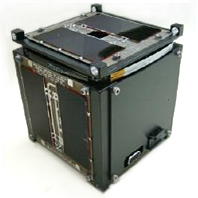About CubeSats
 |
|
|---|---|
| A basic 10x10x10cm cubesat | |
A CubeSat is a miniaturized satellite designed for space science research. It typically has a volume of one liter (a 10cm cube), weighs no more than 1.33 kg, and is built with commercial off-the-shelf electronics components. The basic 10x10x10cm CubeSat is "1U" (one unit), scaleable in 1U increments. A "2U" CubeSat is 20x10x10cm; a "3U" is 30x10x10cm.
The common 10cm height and 10cm width dimensions means they can use a common deployment system, regardless of the length dimension. CubeSat launches are far less expensive than satellite launches and have thus become a cost-effective way for schools and universities to get a payload into orbit.
History of CubeSat Missions
• One of the earliest launches of CubeSats was from Plesetsk, Russia in 2003.
• A second group of three CubeSats was launched from Plesetsk in 2005.
• In February 2006, a single CubeSat was launched from Uchinoura, Japan.
• In July 2006, in Kazakhstan, a launch vehicle with 14 CubeSats disintegrated.
• In December 2006, a single CubeSat was launched from NASA Wallops FF.
• A fourth group of CubeSats was launched from Kazakhstan in April 2007.
• A fifth group of CubeSats developed was launched from India in April 2008.
• In May 2009, a sixth group of CubeSats was launched from NASA Wallops FF.
• A seventh group was deployed from space shuttle Endeavor in July 2009.
• In October 2010, an eighth group was launched from Vandenberg, Calif.
• In November 2010, a NASA mission called ELaNa (Educational Launch of Nanosatellites) launched three CubeSats.
With the history now established, California Polytechnic State University and Stanford University have developed CubeSat specifications to help universities worldwide to participate in space science exploration.
National Science Foundation CubeSat Missions
In 2008, the National Science Foundation announced support for the use of CubeSats in science missions dedicated to space weather and atmospheric research. To date, NSF CubeSat-based science missions include:
• 2010: Radio Aurora Explorer (RAX), now RAX-2; SRI and Univ. Mich.
• 2010: Dynamic Ionosphere CubeSat Explorer (DICE); Utah State Univ.,
Embry-Riddle Aeronautical Univ., Clemson Univ.
• 2012: CubeSat for Ions, Neutrals, Electrons and Magnetic Fields (CINEMA);
Univ. of Calif. Berkeley
• 2012: Colorado Student Space Weather Experiment (CSSWE); Univ. Colo.
• 2013: Focused Investigation of Relativistic Electron Burst Intensity, Range, and Dynamics (FIREBIRD); Univ. of New Hampshire, Montana State Univ.
• 2013: Firefly/FireStation for ISS; Siena College
• In-Design: CubeSat Investigating Atmospheric Density Response to Extreme Driving (CADRE); Univ. Mich.
• In-Design: EXOCUBE; Univ. Wisc., Calif. Polytechnic State Univ.
• In-Design: Lower Atmosphere/Ionosphere Coupling Experiment (LAICE);
Univ. Ill. Urbana-Champaign
• In-Design:Optical Profiling of the Atmospheric Limb (OPAL); Utah State Univ.
FIREBIRD CubeSat 
The FIREBIRD mission will use two identical 1.5U CubeSats (10x10x15cm). The 1U spacecraft will be developed at Montana State University, and the additional .5U portion will hold a sensor module developed at University of New Hampshire.
FIREBIRD CubeSats will have passive magnetic attitude control and will carry 2 solid-state detectors, sensitive to electrons precipitating from the radiation belts.
Students will have major responsibility for the design and implementation of the instruments and the spacecraft, while at the same time being mentored by professionals in each area of expertise.

